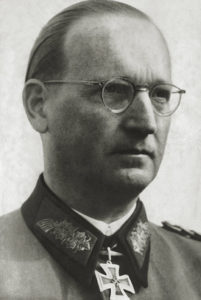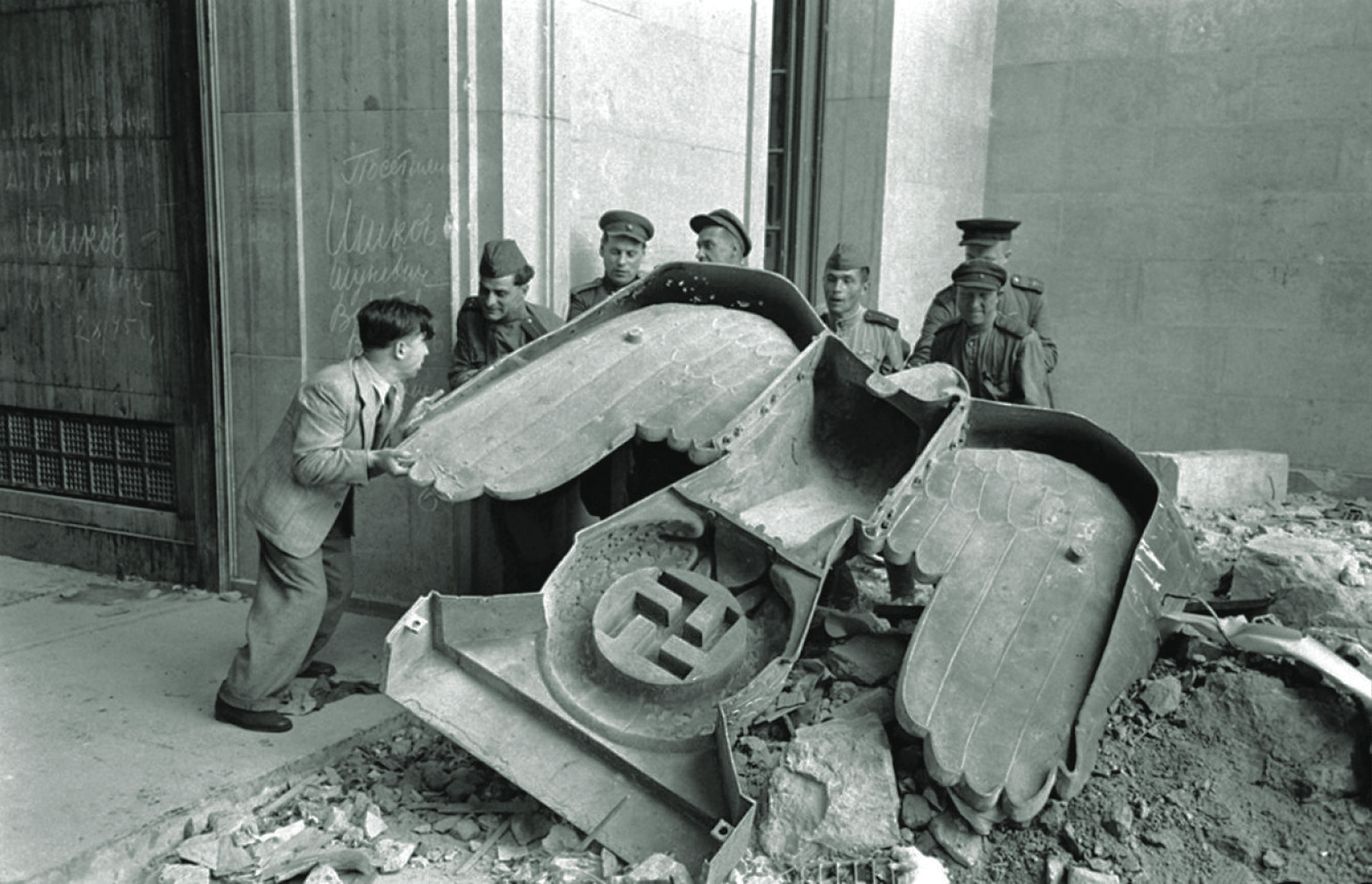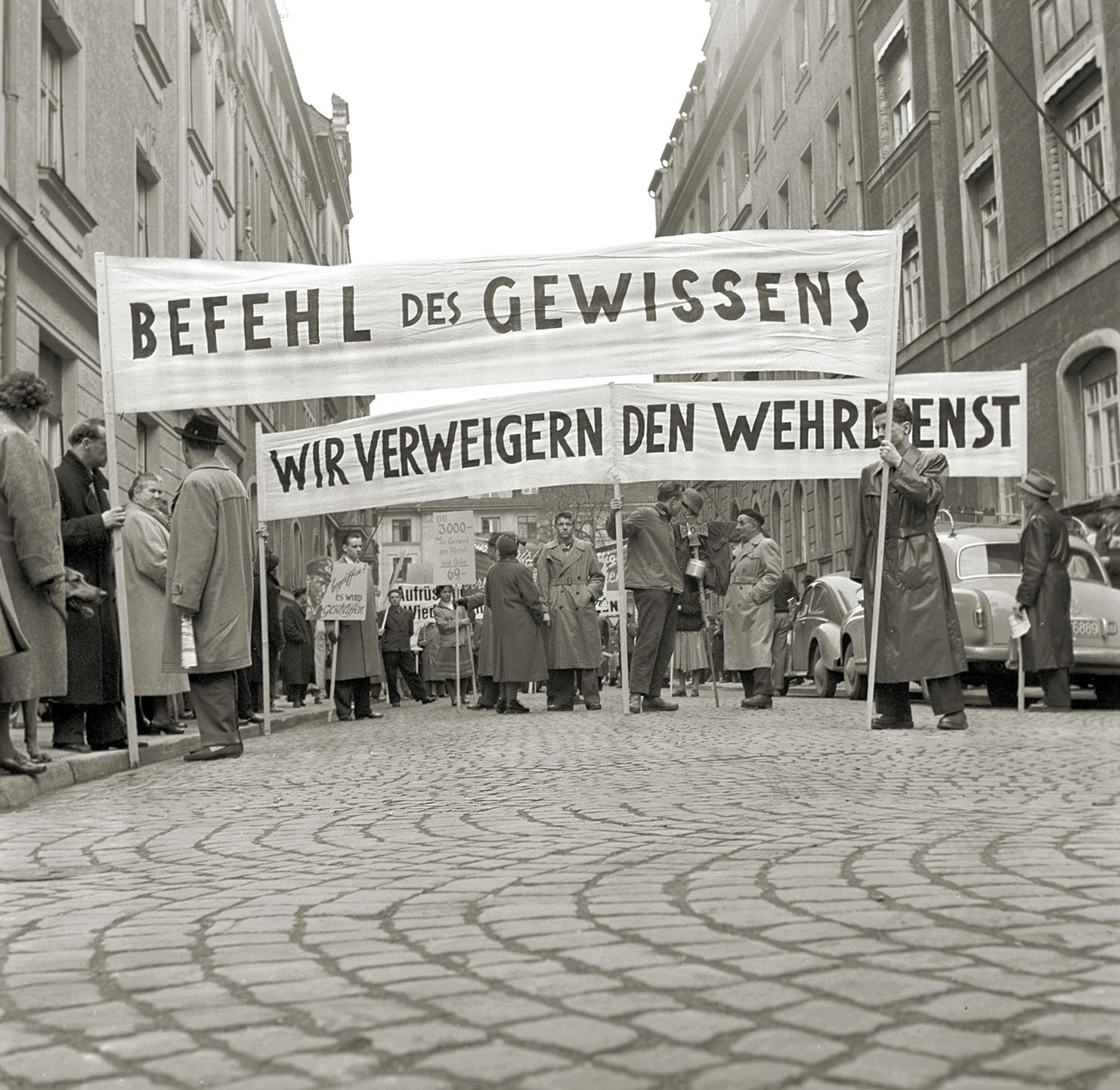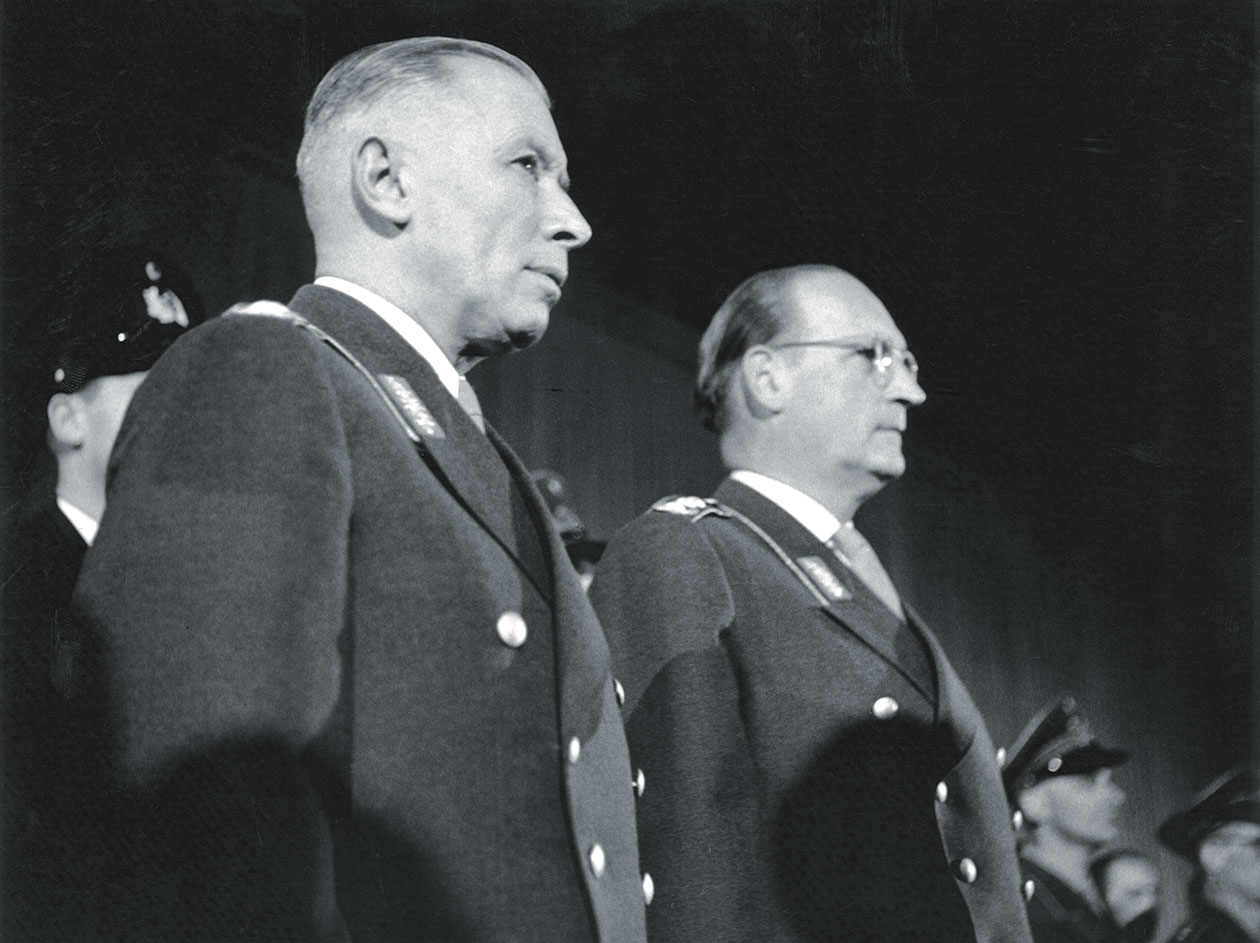Amid the Cold War two German generals were among the few NATO commanders with direct experience fighting the Soviets—not to mention the French, British and Americans
The Wehrmacht—Nazi Germany’s armed forces—surrendered unconditionally to the Western Allies on May 7, 1945. Generaloberst Alfred Jodl, chief of the Wehrmacht Operations Staff, signed the instrument of surrender at the forward command post of the Supreme Headquarters Allied Expeditionary Force in Reims, France. Two days later amid the Berlin ruins Jodl’s boss, Generalfeldmarschall Wilhelm Keitel, chief of the Oberkommando der Wehrmacht, signed an almost identical document in the presence of Soviet, American, British and French commanders. World War II was over for Jodl, Keitel and their countrymen. Unlike what happened at the end of World War I, the victors intended to wholly demilitarize Germany.
The postwar Allied Control Council duly dissolved the Wehrmacht on Aug. 20, 1946. Within a decade, however, the world would look considerably different. In 1949, with the onset of the Cold War, the Western Allies formed the North Atlantic Treaty Organization (NATO), with a unified military command structure. NATO’s primary mission was to deter an increasingly belligerent Soviet Union, which had liberated the countries of Eastern Europe only to occupy and enslave them as communist satellite states. By the mid-1950s NATO ground forces were vastly outnumbered in the heart of Europe. America, France and Britain begrudgingly concluded the only way they could restore some measure of military balance was to rearm their former German enemy, albeit under firm NATO operational control. Thus the Paris Accords of May 5, 1955, authorized the establishment of the Bundeswehr, the armed forces of the Federal Republic of Germany.

Armies cannot be created overnight. Rank-and-file soldiers can be brought in off the streets and trained to minimum effectiveness in about six months. But what about commanders? Where do you find leaders—particularly general officers—with the background and experience to train, organize and lead an army built from scratch?
In West Germany’s case the answer was obvious but complicated. Just 10 years earlier Germany, even in defeat, had one of the best armies in history. Yet the Wehrmacht had been corrupted into the servant of the odious and criminal Third Reich. Germany produced many great generals between 1933 and ’45, but by 1955 many of them were dead, too old or indelibly compromised by complicity in German war crimes or unquestioning subservience to Adolf Hitler and the Nazi Party. The challenge was to find enough former Wehrmacht generals with relatively unblemished records who were willing to return to uniform late in life. Especially challenging was finding qualified officers who had served the Wehrmacht in the most senior positions and, therefore, had the background and experience to become the Bundeswehr’s senior commanders.
The West German government subjected all former Wehrmacht soldiers volunteering for the Bundeswehr to a rigorous screening process. Initially, it permitted only Waffen-SS soldiers at the rank of captain and below to serve. Later it accepted officers up to the rank of lieutenant colonel, provided they passed the screening. Ultimately, 61 Wehrmacht generals and admirals made it through, though by the fall of 1957 only 42 of them had joined the Bundeswehr.
The most senior officers of the latter group were Hans Speidel and Adolf Heusinger, who on Oct. 10 and Nov. 12, 1955, respectively, were sworn in as the Bundeswehr’s first two lieutenant generals. Both turned 58 that year and were joining their fourth German army—starting with the Deutsches Heer of World War I, followed by the Weimar Republic’s interwar Reichswehr, then the Wehrmacht. Though Speidel and Heusinger had been lieutenant generals in the Wehrmacht, both were brought into the new German armed forces one level up. Prior to 1945 a German Generalleutnant had been the two-star equivalent of a British or American major general. The Bundeswehr changed the rank structure to make a new Generalleutnant the three-star equivalent of its NATO allies’ lieutenant generals.
Hans Speidel was born in Metzingen, Germany, on Oct. 28, 1897. Adolf Heusinger was born in Holzminden on Aug. 4, 1897. Speidel’s father was a civil servant, Heusinger’s a schoolteacher. In November 1914 Speidel enlisted as a Fahnenjunker (officer candidate) in the Württemberg army’s 123rd “King Karl” Grenadier Regiment. In June 1915 Heusinger volunteered for the 7th Thuringian Infantry Regiment. After being commissioned a second lieutenant, Speidel served as a company commander at the 1916 Battle of the Somme and spent the remainder of World War I as a battalion adjutant, or operations officer. After his commissioning, Heusinger was severely wounded during the 1916 Battle of Verdun. On returning to duty, he was assigned as a deputy battalion adjutant and then as an intelligence officer. In the fall of 1917 Heusinger was again badly wounded, during the Battle of Passchendaele.
Captured by the British, he was held in a POW camp in Yorkshire, England, until December 1919. Following the war both Speidel and Heusinger entered university. The former studied history and economics at several universities, the latter law and political science at the University of Göttingen. Both were offered commissions in Germany’s small but elite Reichswehr, permitted under the Treaty of Versailles. Speidel’s assignments gave him the flexibility to pursue a civilian education, and he completed his doctorate in 1925. Meanwhile, both completed the Reichswehr’s covert General Staff officer training course, qualifying in 1929. From 1930 to ’34 Heusinger served in the Operations Department of the Truppenamt (Troop Office), the clandestine General Staff, also outlawed under the Versailles Treaty. Speidel undertook language training in France and then was assigned to the Truppenamt’s Foreign Armies West department. In 1933 he was posted to Paris as assistant military attaché.

In 1934 and ’35 Heusinger was a company commander in the 18th Infantry Regiment at Paderborn. For the next two years he served in the 1st Infantry Division in Allenstein (present-day Olsztyn, Poland) as first General Staff officer. The “Ia” (Roman numeral I and “a”) as the position was known, was the division’s combined chief of staff and operations officer. Although the position was typically held, as in Heusinger’s case, by a captain, the Ia was the only fully qualified General Staff officer in a pre-1945 German division.
Returning from Paris in 1935, Speidel also did a tour as a company commander, in the 56th Infantry Regiment, and then as the Ia of the 33rd Infantry Division in Mannheim. Both officers were following standard career development paths for new members of the General Staff. After 1937 their professional paths branched out along more individualized channels.
In August 1937 then Maj. Heusinger returned to Berlin to the Operations Department of the Army High Command (Oberkommando des Heeres, or OKH), the new name for the old Truppenamt. In October 1940 Heusinger became chief of the Operations Department as a colonel. Even at that relatively junior rank, he was the third most senior officer in the army planning hierarchy, after Chief of the General Staff Gen. Franz Halder and his deputy, Generalleutnant Friedrich Paulus. (It was Paulus who would surrender the doomed German Sixth Army to the Soviets at Stalingrad in January 1943.)
Heusinger played a key role in planning the invasion of Poland in 1939; operations in Denmark, Norway, France and the Netherlands in 1940; and Operation Barbarossa, the June 1941 invasion of the Soviet Union. At that point Hitler delegated to OKH primary responsibility for operations in Russia, while the Oberkommando der Wehrmacht (OKW), under Keitel and Jodl, took over operational planning for all other theaters of war. There was constant friction and in-fighting between OKH and OKW, which was exactly how the Führer wanted it.
Promoted to lieutenant colonel in January 1939, Speidel was assigned as the Ia of the IX Army Corps. During the September 1939 campaign in Poland the IX Army Corps manned the Siegfried Line (aka Westwall) to screen Germany against a French invasion. When Germany invaded France in May 1940, Speidel was on the staff of the Sixth Army, part of Generaloberst Fedor von Bock’s Army Group B. After the Sixth Army crossed the Meuse River, Speidel was responsible for developing the plan to encircle Paris in a double envelopment, a classic Prussian Kesselschlacht (“cauldron battle”) maneuver. Speidel’s plan was never executed, as the French defenses simply collapsed. After the armistice Speidel was posted to Paris as chief of staff to Gen. Otto von Stülpnagel, the German military governor of France. Although Stülpnagel was a hardcore Nazi, his cousin, Gen. Carl-Heinrich von Stülpnagel, was among the first of Germany’s senior military leaders to become disillusioned with Hitler and Nazism.

Promoted to major general in December 1941, Heusinger was also beginning to develop serious doubts about Hitler. A key planner of Case Blue (Fall Blau), the summer 1942 resumption of offensive operations in Russia, Heusinger and his superior, Halder, repeatedly clashed with the Führer over the conduct of the campaign. Both generals strongly favored a resumption of the push toward the Soviet capital, Moscow. Hitler instead insisted the Germans drive southeast, toward Stalingrad and the Caucasus.
Simultaneously, Hitler insisted on a major drive in the north to eliminate the encircled city of Leningrad. Thus, the Wehrmacht extended its diminishing combat power along two widely diverging axes. Predictably, things quickly went downhill. In retaliation, Hitler sacked Halder in September 1942 and replaced him with General Kurt Zeitzler. Heusinger remained chief of the OKH Operations Department.
In March 1942 Speidel was appointed chief of staff of the V Army Corps in Russia. In January 1943, at the height of the Stalingrad crisis, Speidel was temporarily assigned as chief of staff to Gen. Kurt von Tippelskirch, the German liaison officer to and de facto commander of the Italian Eighth Army, then fighting to relieve the Sixth Army from the north.
After Stalingrad fell, Speidel organized the staff of the ad hoc Army Detachment Kempf. In that position in early 1943 he played a significant role in stabilizing the German southeastern sector and laid the administrative and logistical groundwork for Generalfeldmarschall Erich von Manstein’s masterful counterstroke at Kharkov that February. Five months later Speidel served as Gen. Werner Kempf’s chief of staff during the Battle of Kursk. Shortly thereafter Speidel was promoted to major general and appointed chief of staff of the Eighth Army under Gen. Otto Wöhler. Speidel received the Knight’s Cross of the Iron Cross for his services in Russia and was promoted to lieutenant general in January 1944.
By the time he was transferred to the Western Front in April 1944, Speidel had seen enough of Germany’s barbaric and genocidal extermination policies in Russia to become a staunch anti-Nazi. He was convinced Hitler had to go before he destroyed what was left of an already crumbling Germany. Legendary Generalfeldmarschall Erwin Rommel had personally requested Speidel as his chief of staff at Army Group B in Normandy. The two were fellow Swabians, had met during World War I and had served in the same infantry regiment briefly during the interwar period.
More important, Speidel was the kind of intuitive and independent-minded officer to whom Rommel could entrust the daily operations of his group headquarters while the action-oriented commander spent time with his forward units. Ironically, Speidel spent almost all of D-Day running Army Group B while Rommel raced back to Normandy from his home in Herrlingen (present-day Blaustein), where he had gone off on a jaunt to see his wife on her birthday.
On returning to France, Speidel had reestablished contact with Carl-Heinrich von Stülpnagel, who in February 1942 had succeeded cousin Otto as military governor. Speidel already had strong connections with Carl Friedrich Goerdeler, the civilian leader of the anti-Nazi faction. Through Stülpnagel, Speidel became one of the senior military members of the German opposition to Hitler. He was never an inner member of the cell led by Oberst Claus von Stauffenberg, but he knew of the Operation Valkyrie plot. Rommel met Stülpnagel through Speidel, though it remains unclear just how deeply Rommel became involved in the plot against Hitler. He certainly had some knowledge of what was transpiring, and the conspirators were eager to enlist Germany’s most high-profile field marshal in their cause. They had been in contact with Allen Dulles of the U.S. Office of Strategic Services, but as late as May 16 they reported to the American spymaster that Rommel was not to be trusted.
On July 17 Rommel was seriously wounded in Normandy when an RAF fighter strafed his command car. Three days later Stauffenberg carried a briefcase bomb into Hitler’s command bunker in East Prussia.
Heusinger was standing directly beside Hitler when the bomb went off. On June 10 the Führer had sacked Zeitzler as chief of the General Staff and appointed Heusinger acting chief until Generaloberst Heinz Guderian could take over. While Heusinger knew about the military opposition and empathized with them, he had no knowledge of Operation Valkyrie. When the bomb went off, he suffered head, arm and leg injuries. Three days later, while still in the hospital, Heusinger was arrested and interrogated by the Gestapo. The fact he had been standing beside Hitler certainly weighed in the general’s favor, and the Gestapo was ultimately unable to connect him directly to the conspiracy.
Released from custody in October 1944, Heusinger was assigned to the Führerreserve, a holding pool for senior Wehrmacht officers. Not until March 1945 did he return to an active assignment, as chief of the Wehrmacht’s Mapping Department, a position far below the one he’d held as acting chief of the General Staff. In May 1945 American troops captured Heusinger.
In the wake of Operation Valkyrie the Gestapo rounded up the lead conspirators. Stauffenberg was executed that very night. Recalled to Berlin, Stülpnagel failed to take his own life and was executed in late August. Sent to govern greater Paris in his stead was Gen. Dietrich von Choltitz. Speidel had eluded the Gestapo’s attention for a time. But he fell under suspicion again in late August after conspiring with Choltitz to circumvent Hitler’s direct order to reduce Paris to a “debris field” rather than surrender the French capital intact to the Allies. The Gestapo arrested Speidel on September 7. Under torture he maintained neither he nor Rommel had ever been part of the conspiracy against Hitler, and Speidel never implicated other conspirators.
The Wehrmacht court-martialed Speidel, if for no other reason than to keep him out of the dreaded Volksgerichthof (“People’s Court”) of Judge Roland Freisler, who condemned some 2,600 members of the political opposition. The military court found Speidel “not guilty, but not free from suspicion,” an odd verdict to be sure, but one that kept him under Wehrmacht jurisdiction. By then, despite Speidel’s denials, Hitler was convinced Rommel either must have been involved or must have known about the plot. Pressured by Hitler’s direct threat against his family, the field marshal committed suicide on Oct. 14, 1944. Speidel was imprisoned in the fortress of Küstrin east of Berlin. As the Red Army closed in on the spring of 1945, the SS moved all prisoners to the Hersberg Castle in Immenstaad, on the opposite shore of Lake Constance from Switzerland. With the help of the prison commandant Speidel organized an escape and went into hiding. He was captured by French troops on April 29, 1945.

After the war Speidel returned to academia as a professor of modern history at the University of Tübingen. His 1950 book Invasion 1944 relates the Allies’ Normandy landings from the German perspective. Speidel also served the West German government as a defense consultant. As a key military adviser to Chancellor Konrad Adenauer, he was among the principal authors of the 1950 Himmerod Memorandum, the republic’s classified internal study of the logistics of rearmament. In 1954 the republic appointed Speidel its chief negotiator on the question of German entry into NATO.
Heusinger, a POW until 1948, testified as a witness for the defense at the U.S. Military Tribunal’s High Command Trial at Nuremberg. From 1948 to ’50, under the code name Adolf Horn, he was chief of evaluation for the Gehlen Organization, West Germany’s nascent intelligence agency. Established in 1946 by former Wehrmacht Generalleutnant Reinhard Gehlen, the organization transformed into the present-day Bundesnachrichtendienst (BND), the German counterpart to the CIA. At the same time Heusinger served under his onetime superior, Halder, as deputy chief of German military studies for the U.S. Army Historical Division. In January 1951 Heusinger, Speidel and Chancellor Adenauer met to discuss German rearmament with U.S. High Commissioner John Jay McCloy and General of the Army Dwight Eisenhower, NATO’s supreme Allied commander in Europe.
Heusinger and Speidel were appointed senior members of the Blank Office, which on June 7, 1955, became West Germany’s Federal Ministry of Defense, with civil servant Theodor Blank as its first minister. Once commissioned as the Bundeswehr’s first two general officers, Speidel was assigned as chief of the Combined Forces Department at the Ministry of Defense, while Heusinger chaired the Military Leadership Council. In 1957 Speidel and Heusinger were promoted to become the Bundeswehr’s first four-star generals.
That spring Heusinger succeeded Speidel as chief of Combined Forces when the latter was appointed commander in chief of Allied Land Forces in Central Europe (COMLANDCENT), becoming the first German officer to hold a NATO commander in chief position. Working from headquarters at France’s Fontainebleau Castle, Speidel managed the Bundeswehr’s integration into NATO. Although he had never commanded anything larger than a company, he was the senior operational commander of all German, American, French and British divisions assigned to NATO’s Central Region. If war had broken out with the Soviet Union and the Warsaw Pact, Speidel would have been the senior NATO ground commander.
That summer Heusinger was appointed the first inspector general of the Bundeswehr, becoming Germany’s senior serving military officer, the equivalent of the U.S. chairman of the Joint Chiefs of Staff. Given the historical baggage connected with the title “chief of the German General Staff,” the government had opted for a new title.
The early Bundeswehr also struggled to come to terms with Germany’s tainted military past and even the assassination attempt on Hitler. An ambivalent German public couldn’t decide whether Stauffenberg and his fellow conspirators were heroes or traitors. The Bundeswehr made a conscientious decision to embrace the tradition of soldiers who had put their conscience above blind military obedience. “Their spirit and their attitude is our model,” Heusinger wrote to his subordinate commanders in 1959.
Heusinger served as inspector general until 1961, when appointed chairman of NATO’s Military Committee—the organization’s senior military officer and chief military adviser to the secretary general. Heusinger was the first German officer to hold that position and a central figure in the fierce debate over how NATO would fight any future wars. One school of thought held that nuclear weapons rendered conventional forces and operational techniques obsolete. Rejecting that position, Heusinger argued for the concept of a graduated response by NATO, combined with the concurrent strengthening of conventional forces. He saw his theories vindicated in the early 1960s when the Kennedy Administration adopted the doctrine of “flexible response.”
Speidel retired in September 1963, Heusinger in April 1964. They died on Nov. 28, 1984, and Nov. 30, 1982, respectively. They and the handful of former Wehrmacht general officers who had remained in uniform were the last of a breed. The shooting may have stopped in 1945, but the arc of World War II remained a living force in the armies of the world for years afterward. MH
Retired U.S. Army Maj. Gen. David T. Zabecki is Historynet’s chief military historian. For further reading he recommends The Myth and Reality of German Warfare: Operational Thinking From Moltke the Elder to Heusinger, by Gerhard P. Gross; and the chapter on Hans Speidel, by Russell Hart, in the book Chief of Staff: The Principal Officers Behind History’s Great Commanders, Vol. II, World War II to Korea and Vietnam, edited by Zabecki.
This article appeared in the November 2021 issue of Military History. For more stories, subscribe and visit us on Facebook.





